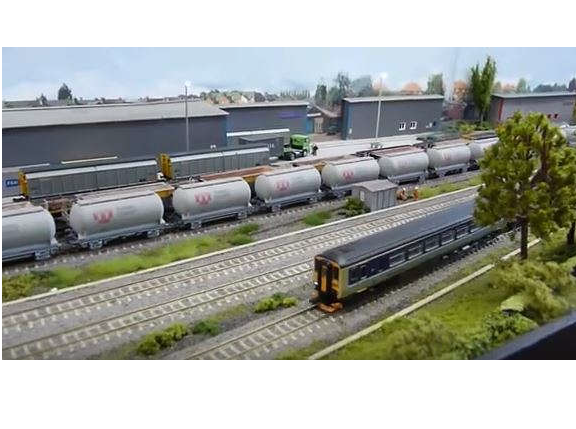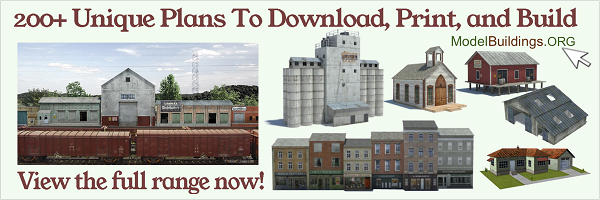Using Backdrops To Provide Depth and Scenic Background Realism For Model Trains, Buildings, Structures, and Scenery on Railroad Layouts
A model train backdrop is a background panel that gives a sense of distance andperspective to your model railroad. It is not something that features a series of physical items, but rather creates a believable distant horizon which seems to extend the scene out to infinity. For example, you might create a backdrop that features a series of trees in the background alongside an open sky with a few clouds. This is used to help create the look of a forest area. © Copyright http://www.modelbuildings.org All rights reserved.
If your model train layout features an urban setting, a backdrop with a few buildings in the background should be considered. This may be used to suggest that your scene takes place in the middle of a larger city and that the part you are using is only a small portion of a larger city landscape.

Why Would a Backdrop Work?
This backdrop of houses adds dimension and makes the housing estate look much bigger. Photos can be glued onto a background or sky.
There are many reasons why a backdrop should be used. First, it can help you to cover up anything that might get in the way of your scene. These include things like wires, wall items and other items that might get in the area. You want the backdrop to blend into the scene and help pull it all together and not itself be a distracting point of focus.
Sometimes it helps to add transparency by using a graphics program on your computer to soften the color intensity. This can make buildings look more distant.
Next, a model train backdrop can be an effective scene transition. On a layout featuring a rural setting, a backdrop with a distant city skyline suggests that the train may be moving toward the city as a final destination to unload its cargo.
It also helps to create a good horizon that can be seen in the back. This horizon will showcase the entire area you are trying to create and will make objects in the scene blend together to make an attractive whole rather than a group of random independent elements.
Even a plain backdrop with clouds on it will be useful. If you know a person with some artistic talent, you might be able to encourage them to paint a simple blue gradient background and a couple of puffy white clouds in the far distance.
Painting Your Own Model Train Layout Backdrop
There are some advantages to creating your own railroad backdrop. You add elements to it for that personal touch that you want to use to
express what makes the entire area special or unique.
Search the internet for sky photos and also step outside and have a good look at how the sky looks. When the clouds are directly overhead they are often further apart and seem to get closer together the closer they are to the horizon. The bottoms of the cloud are in shadow. A closer look and you’ll see the sky is bluer overhead and will get more hazy and gray as it stretches to the horizon.

Choose a light blue (sky color) and light gray paint that looks appropriate under the lighting. Test out your painting skills on a scrap of masonite or drywall. Apply the blue (with a 3″ paint brush) using horizontal strokes starting at the top and working down to about halfway. While the paint is still wet brush on a mix of grayish white paint using horizontal strokes starting from the bottom and working up into the blue paint. Don’t press the paint brush too firmly as you paint. The aiis to blend the colors where they meet, not to paint over the blue. A foam brush or sponge can be used for painting the clouds. The trick is to blend the clouds without any sharp edges. Some little test pots of paint come with a built-in foam dispenser brush which is ideal.
Buying a commercially made backdrop is also an option. However, you would be at risk of having some real limits in terms of what you can and cannot create for your backdrop. This could be due to the limited colors used or even the restriction on the size of your backdrop. Even the theme of a previously-made backdrop could prove to be a challenge. It might be possible to combine elements of commercial backdrops to get just the right effect you’re looking for. Often, commercial backdrops are photographs that have been blown up and can be cut and pasted to customize if you are careful to hide the seams where things have been joined. Check how detailed the backdrop is; they can range from 300 print dots/inch to 600 dots/inch. Some backdrop suppliers can even digitally blend one scene into another scene. For example; an oil refinery could be gradually blended into an agricultural or mountain scene.
The process of creating such a backdrop on your layout should not be too difficult. You have to do the following:
1. Consider what your theme is going to be. How will the backdrop reflect the theme that you have selected?
2. Pay attention to the colors you are using in your scene. You should use colors that can match up well with the scene and appear to be as realistic as possible.
3. Be aware of perspective. Objects that are in the forefront on your backdrop should appear larger than those in the distance.
Creating the Model Railroad Backdrop
First, choose an appropriate material:
• A good matte paper backdrop can be used to create a surface that readily accepts paint. The paper backdrop will need some kind of support framework as well.
• A canvas design could be more durable not fade over time.
• Masonite is a very popular material for backdrops. It not only takes paint well, it is easy to form into curved shapes so that you need not restrict the benchwork of your layout to rectangular shapes.
• You might even take a look at the walls where your layout is to see if a backdrop might be painted on them directly. The texture of the wall could possibly be used to suggest detail features or be used to enhance or focus attention to an area.


